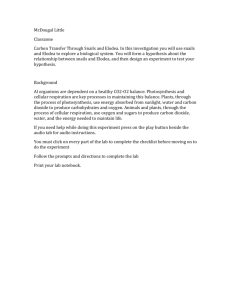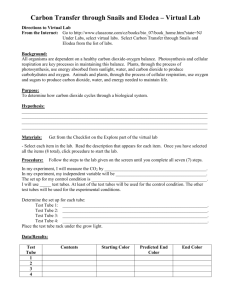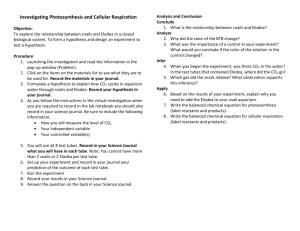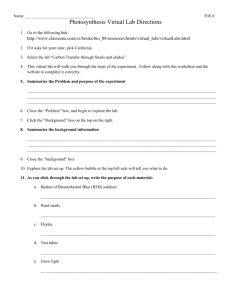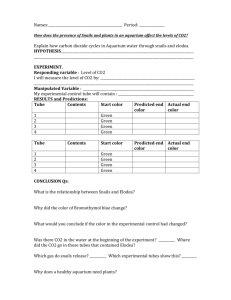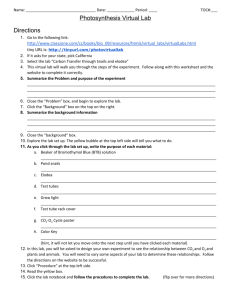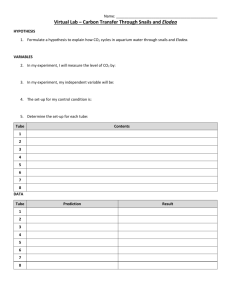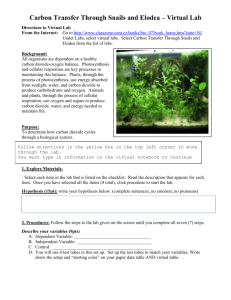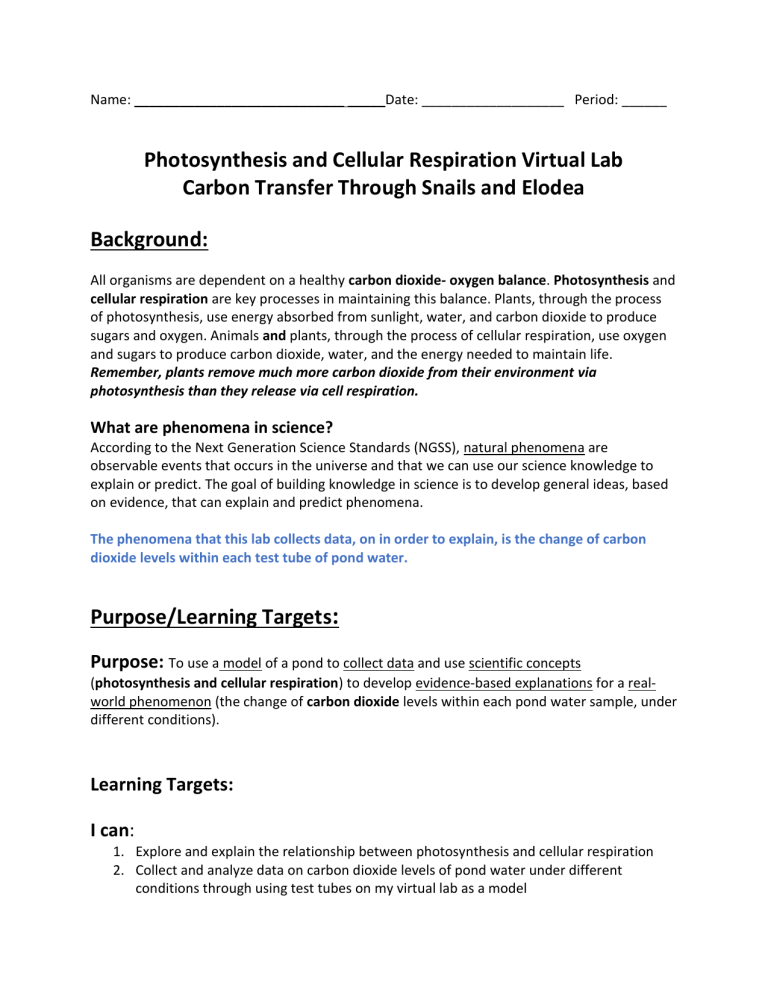
Name: ____________________________ _____Date: ___________________ Period: ______ Photosynthesis and Cellular Respiration Virtual Lab Carbon Transfer Through Snails and Elodea Background: All organisms are dependent on a healthy carbon dioxide- oxygen balance. Photosynthesis and cellular respiration are key processes in maintaining this balance. Plants, through the process of photosynthesis, use energy absorbed from sunlight, water, and carbon dioxide to produce sugars and oxygen. Animals and plants, through the process of cellular respiration, use oxygen and sugars to produce carbon dioxide, water, and the energy needed to maintain life. Remember, plants remove much more carbon dioxide from their environment via photosynthesis than they release via cell respiration. What are phenomena in science? According to the Next Generation Science Standards (NGSS), natural phenomena are observable events that occurs in the universe and that we can use our science knowledge to explain or predict. The goal of building knowledge in science is to develop general ideas, based on evidence, that can explain and predict phenomena. The phenomena that this lab collects data, on in order to explain, is the change of carbon dioxide levels within each test tube of pond water. Purpose/Learning Targets: Purpose: To use a model of a pond to collect data and use scientific concepts (photosynthesis and cellular respiration) to develop evidence-based explanations for a realworld phenomenon (the change of carbon dioxide levels within each pond water sample, under different conditions). Learning Targets: I can: 1. Explore and explain the relationship between photosynthesis and cellular respiration 2. Collect and analyze data on carbon dioxide levels of pond water under different conditions through using test tubes on my virtual lab as a model 3. Use patterns within my data to explain why the carbon dioxide levels changed under different conditions, through using my understanding of photosynthesis and cellular respiration a. Describe how different amounts of light can affect the rate of photosynthesis b. Explore and explain the relationship between photosynthesis (elodea) and cellular respiration (snails) within the pond water Procedure: Follow all seven (7) steps to the virtual experiment “ Carbon Transfer Through Snails and Elodea” found on this website: http://www.classzone.com/cz/books/bio_07/resources/htmls/virtual_labs/virtualLabs.html **Link posted on Google Classroom IMPORTANT: You will need to fill out the lab notebook, online, as you go through each step, in order to advance to the next step, yet you will only be graded on what you put on this assignment sheet! 1. Read through the problem tab. Our research questions are: How does the presence of just snails, just Elodea, and both snails and Elodea change the amount of carbon dioxide (CO2) within aquarium water? Why does this happen? 2. Explore the lab to learn what is available to you in your investigation. You must click on each item in the checklist before being able to advance in the lab. Describe the materials you will be using in this lab. a. What is Bromothymol Blue? Why is the BTB in the beaker green? b. If snails use lungs to breathe, you can conclude that they release which gas into their environment as a result of cellular respiration? c. If Elodea is an aquatic plant, you can conclude that it releases which gas into its environment as a result of photosynthesis? d. What is the purpose of the growth light? e. What is the purpose of the test tube rack cover f. If no/little carbon dioxide is present in your test tube it will be a ____________ color. If a medium amount of CO2 is present, your test tube will be a __________ color. If a large amount of CO2 is present, your test tube will be a _______________ color. Hypothesis: Explain the relationship between snails and Elodea on how carbon dioxide (CO2) cycles through aquarium water (Explain the relationship between photosynthesis and cellular respiration) IF: I add snails and elodea (that has light) to a test tube with bromothymol blue THEN: the amount of carbon dioxide within the test tube WILL: A) increase, B) decrease, or C) remain the same (HIGHLIGHT one of those three) BECAUSE: Identify Variables: 1. Independent Variable (what is changed/altered by you in the test tubes): 2. Dependent Variable (what is being measured): 3. Control Variables (what is kept the same between experimental groups)- LIST TWO: A. B. Data/Results: You will be using 8 test tubes for this experiment. Fill your test tubes and perform the experiment according to the data chart found below. First Test Tube Rack- PLACED UNDER THE GROWTH LIGHT: Test Tube with BTB Independent Variables Beginning Color Tube #1 (Control) No snails, No Elodea Green Tube #2 2 Snails Green Tube #3 2 Elodea Green Tube #4 2 Snails, 2 Elodea Green Color Prediction Color Result COLOR CHOICES ARE: BLUE, GREEN, OR YELLOW Second Test Tube Rack- PLACED UNDER THE TEST TUBE COVER (NO LIGHT!): Test Tube with BTB Independent Variables Beginning Color Tube #1 (Control) No snails, No Elodea Green Tube #2 2 Snails Green Tube #3 2 Elodea Green Tube #4 2 Snails, 2 Elodea Green Color Prediction Color Result COLOR CHOICES ARE: BLUE, GREEN, OR YELLOW Conclusion: Write a conclusion using the CER model that answers the research question: MAKE SURE YOU FINISH THE FOLLOWING SENTENCES AND WHEN YOU READ IT BACK TO YOURSELF, IT MAKES SENSE.(is a COMPLETE SENTENCE) C: **Complete the following sentences regarding the AMOUNT OF CARBON DIOXIDE (CO2) within each test tube, compared to the control test tubes: You must mention the amount of carbon dioxide for each below as your claim! a. In the test tubes which contained only snails… b. In the test tubes which contained only Elodea under the light… c. In the test tubes which contained only Elodea in the dark… d. In the test tubes which contained both snails and Elodea under the light… E: **What evidence do you have for each claim above? WHAT COLOR did the pond water change in each condition? You must mention the color of the water for each below as your evidence! a. In the test tubes which contained only snails… b. In the test tubes which contained only Elodea under the light… c. In the test tubes which contained only Elodea in the dark… d. In the test tubes which contained both snails and Elodea under the light… R (why did what happen, happened?): ONLY write the R for scenario d up above. Discussion: 1. Conclude: What is the relationship between snails and Elodea regarding the cycle of carbon dioxide within aquarium water? 2. Analyze: Why did the color of the Bromothymol Blue (BTB) solution change in certain test tubes? (What caused the color change?) 3. Analyze: What was the importance of a control in your experiment? What would you conclude if the color of the solution in the control changed? 4. Infer: When you began the experiment, was there CO2 in the water? In the test tubes that contained Elodea, where did the CO2 go? 5. Infer: Which gas did the snails release? What observation supports this inference? 6. Apply: Based on the results of your experiment, explain why you need to add the Elodea to your snail aquarium?
